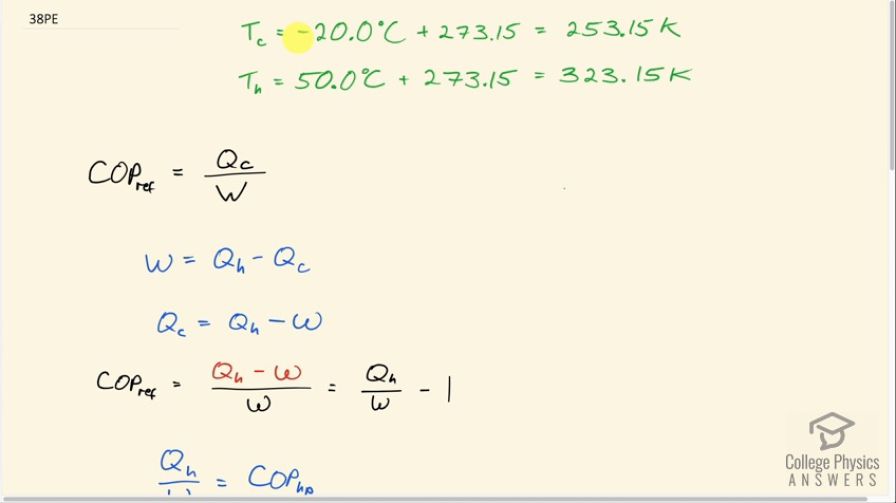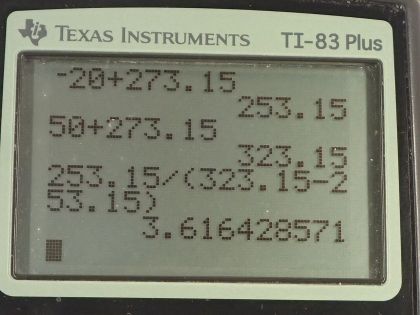Question
Suppose you have an ideal refrigerator that cools an environment at and has heat transfer to another environment at . What is its coefficient of performance?
Final Answer
3.62
Solution video
OpenStax College Physics for AP® Courses, Chapter 15, Problem 38 (Problems & Exercises)

vote with a rating of
votes with an average rating of
.
Calculator Screenshots
Video Transcript
This is College Physics Answers with Shaun Dychko. We are going to calculate the coefficient of performance for an ideal refrigerator operating between a cold temperature of minus 20.0 degrees Celsius and a high temperature of hot reservor of 50.0 degrees Celsius and both of these get converted into Kelvin. So coefficient of performance for a refrigerator means it's taking this much heat from the cold temperature reservoir and it took this much work energy to do that transfer and it transfers this heat from the cold temperature reservoir into the hot temperature reservoir so it takes heat from the cold refrigerator and puts it into the hot room for example. Now we need to find a different way to express this fraction in terms of these temperatures knowing that this is a Carnot engine so to speak... an ideal refrigerator. So first of all, we place this Q c in terms of work and the amount of energy deposited into the high temperature reservoir. So work is this difference between the amount of heat that's put into the high temperature reservoir minus the amount of heat taken out of the cold temperature reservoir and we'll solve this for Q c; we'll add Q c to both sides and subtract w from both sides and then replace Q c with Q h minus w and this becomes Q h over w minus 1 and the reason this is useful is because this fraction is the coefficient of performance for a heat pump and we have relationship between coefficient of performance for heat pump and the Carnot engine formula and that Carnot engine formula is in terms of the absolute temperatures. Okay! So let's replace Q h over w with coefficient of performance for heat pump. So the coefficient of performance for a refrigerator is one less than the coefficient of performance for a heat pump. Now efficiency is work divided by heat or total energy either taken from the high temperature reservoir or put into the high temperature reservoir in this case and the coefficient of performance for a heat pump is the same thing but flipped over so to the negative 1 so the coefficient of performance for heat pump is Q h over w and efficiency is w over Q h and so that makes coefficient of performance for heat pump the reciprocal of efficiency or efficiency to the negative 1, in other words. So we can replace COP hp with efficiency to the negative 1 and I have put the subscript c here to say Carnot because this is an ideal refrigerator operating with a Carnot cycle. So we have a formula for the efficiency of a Carnot engine and it's one minus the cold temperature divided by the hot temperature and we can write this as a single fraction by multiplying this 1 by T h over T h and we have T h minus T c all over T h and then as a single fraction now we can flip it or raise it to the exponent negative 1 when we make a substitution here. So Carnot efficiency to the negative 1 is the reciprocal of this fraction and so I have written T h over T h minus T c and then let's write this as a single fraction as well to clean it up a little. So we'll multiply this by T h minus T c over T h minus T c and we end up with T h minus T h minus T c all over T h minus T c and the T h's make zero here and this becomes positive T c because this minus sign and this minus sign make a plus. Okay! So we have T c over T h minus T c this is a whole long story to get to this equation here which is the coefficient of performance for an ideal refrigerator. So the cold temperature divided by the hot temperature minus the cold temperature. So that's 253.15 Kelvin divided by 323.15 Kelvin minus 253.15 Kelvin giving a coefficient of performance of 3.62.
